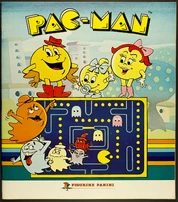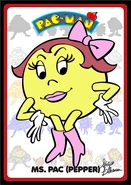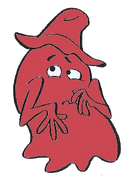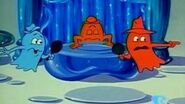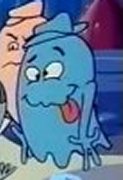Not to be confused with Pac-Man and the Ghostly Adventures.
Pac-Man, also known as Pac-Man: The Animated Series and often referred to as Hanna-Barbera's Pac-Man by fans, is an animated television series produced by Hanna-Barbera in association with Bally Midway and Namco. It premiered on ABC and ran for 44 episodes over two seasons from September 25, 1982, to November 5, 1983.
Pac-Man is notable for being the first animated television series based on the Pac-Man video games, and the first television series based on a video game in general.
Overview[]
Pac-Man follows the adventures of Pac-Man and his family: his wife, Ms. Pac-Man (also referred as "Pepper") and their infant son Pac-Baby; occasionally accompanied by his pet dog Chomp-Chomp and pet cat Sour Puss, who live in the Pac-Village of Pac-Land. Pac-Land is a land inhabited by spherical Pac-People, using and making round designs for many objects and locations. The people of Pac-Land regularly use Power Pellets for everyday purposes, which are the power source of Pac-Land. Power Pellets are naturally generated through Power Pellet trees in the Power Pellet Forest. Pac-Man works at the local Power Pellet forest as the chief of security, working alongside his co-workers such as Grump, Morris and others.
Pac-Man acts as the guardian of the Power Pellets, and protects the power source from a group of Ghost Monsters led by the wizard Mezmeron attempting to steal them, who intend to use the energy of the Power Pellets to seize control of Pac-Land. The ghost monsters consist of Clyde, the leader and most aggressive of the ghosts; Pinky, the toughest and slow man with advanced shape-shifting abilities; Inky, the dumb and clumsiest of the ghosts often carrying around resources for the group; Blinky, the most timid and cowardly of the ghosts; and Sue, the swiftest and only woman in the group. The Ghost Monsters tend to ambush Pac-People by chasing him until they are cornered, where the Ghost Monsters chomp on their bones and cause them to deflate. By using the Power Pellets, the Pac-People are able to gain strength and use their power to eat the Ghost Monsters and combat Mezmeron, foiling their schemes and forcing them to retreat and plan out their next attempt to stop the Pac-People. Mezmeron resides in his lair located on a tall mountain outside of Pac-Land, while the Ghosts regularly live in a small shack outside of Mezmeron's lair. When the Ghosts are eaten, they escape with their eyes and retreat to either their house or Mezmeron's lair to put on a new body, where the ghosts regularly keep in a grand amount inside their closets.
Other recurring plot lines involve Pac-Baby causing trouble for Pac-Man, Sour Puss attempting to humiliate Chomp-Chomp in various ways but always failing, and the Ghost Monsters' nephew Dinky causing trouble for the Ghosts. In the show's second season, the series introduces two recurring characters: Super-Pac, a superhero from another dimension helping Pac-Land in grave situations but also inept at controlling his powers, and P.J.; Pac-Man's self-proclaimed cool nephew who often drags his uncle into various situations that frustrate or humiliate him.
Cast[]
- Marty Ingels — Pac-Man
- Barbara Minkus — Ms. Pac-Man
- Russi Taylor — Pac-Baby
- Neil Ross — Clyde
- Barry Gordon — Inky
- Chuck McCann — Pinky, Blinky
- Susan Silo — Sue
- Allan Lurie — Mezmeron
- Frank Welker — Chomp-Chomp, Morris
- Peter Cullen — Sour Puss, Entry Man (Southpaw packy)
- Lorenzo Music — Super-Pac
- Darryl Hickman — P.J
- Julie McWhirter — Dinky
- Jodi Carlisle (Season 1)
- Paul Kirby (Season 1 & 2)
- Lennie Weinrib - Pacula
- Bill Callaway (Season 2)
- Brian Cummings (Season 2)
- Pat Fraley (Season 2)
- Joan Gerber (Season 2)
- Arte Johnson (Season 2)
- Chris Latta (Season 2)
- Kris Stevens (Season 2)
- Andre Stojka (Season 2)
- Janet Waldo (Season 2)
Episodes[]
Season 1 (1982)[]
| Episode No. | First segment | Second segment | Original airdate |
|---|---|---|---|
| 1 | Presidential Pac-Nappers | Picnic in Pacland | September 25, 1982 |
| 2 | The Great Pac-Quake | Hocus Pocus Pac-Man | October 2, 1982 |
| 3 | Southpaw Packy | Pac-Baby Panic | October 9, 1982 |
| 4 | Pacula | Trick or Chomp | October 16, 1982 |
| 5 | Super Ghosts | The Pac-Man in the Moon | October 23, 1982 |
| 6 | Journey to the Center of Pac-Land | Invasion of the Pac-Pups | October 30, 1982 |
| 7 | Sir Chomp-A-Lot | The Day the Forest Disappeared | November 6, 1982 |
| 8 | Neander Pac-Man | Backpackin' Packy | November 13, 1982 |
| 9 | The Abominable Pac-Man | The Bionic Pac-Woman | November 20, 1982 |
| 10 | Chomp-Out at the O.K. Corral | Once Upon a Chomp | November 27, 1982 |
| 11 | The Pac-Love Boat | The Great Power-Pellet Robbery | December 4, 1982 |
| 12 | A Bad Case of the Chomps | Goo-Goo at the Zoo | December 11, 1982 |
| 13 | Nighty Nightmares | The Pac-Mummy | December 18, 1982 |
Season 2 (1983)[]
| Episode No. | First segment | Second segment | Original airdate |
|---|---|---|---|
| 1 | Here's Super-Pac! | Hey, Hey, Hey...It's P.J | September 17, 1983 |
| 2 | The Super-Pac Bowl | Journey Into the Pac-Past | September 24, 1983 |
| 3 | The Old Pac-Man and the Sea | Public Pac-Enemy No. 1 | October 1, 1983 |
| 4 | The Genie of Pacdad | Computer Packy | October 8, 1983 |
| 5 | The Greatest Show in Pac-Land | Pac-A-Thon | October 15, 1983 |
| 6 | Dr. Jekyll & Mr. Pac-Man | Around the World in 80 Chomps | October 22, 1983 |
| 7 | Super-Pac vs. Pac-Ape | P.J. Goes Pac-Hollywood | October 29, 1983 |
| 8 | Pac-Van-Winkle | Happy Pacs-Giving | November 5, 1983 |
Specials[]
| Special | Notes | Original airdate |
|---|---|---|
| Pac-Man Halloween Special |
|
October 16, 1982 |
| Christmas Comes to Pac-Land |
|
December 16, 1982 |
Development[]
Hanna-Barbera first tried to get the rights to make a Pac-Man series in 1980, following the monumental success of the game. The studio would finally land the rights in 1982,[1] and the studio asked one of their writers, Mark Evanier, to be head writer for the series. Hanna-Barbera even offered Evanier a Pac-Man arcade cabinet if he accepted, but he turned the offer down, and the role went to Jeffrey Scott.[2] Hanna-Barbera quickly cast most of the characters, except for Pac-Man himself. The studio had 174 applicants for the role, and could not decide who to choose.
Elsewhere, Marty Ingels, who besides being an actor and comedian was a talent agent, was looking for a role for one of his clients, actor Robert Culp. Meaning to call Universal Studios, Ingels accidentally phoned Hanna-Barbera, and Ingels talked to Hanna-Barbera casting director Gordon Hunt anyways. Despite having no idea what Pac-Man was, Ingels felt that his client Culp would be a good fit for the role. Hunt on the other hand, felt that Ingels himself was a better fit, and asked Ingels to come down to the studio so he could audition for the role. Ingels refused, not wanting to be an actor anymore, but presumably still offered Culp. Hunt recorded Ingels talking, and showed the tape to executives from ABC, who aired the show, Bally-Midway and Namco. [3] Two days later, Hunt called Ingels back, and Ingels, who was thinking the role would go to Culp, was surprised to hear that he had been chosen and that he was set to come down to Hanna-Barbera the next morning.
Ingels described voicing Pac-Man as a "dream job", saying that he could go to Hanna-Barbera in his pajamas and record three weeks' worth of voice acting in an afternoon, and that he was paid more for the role than he was doing live-action work. He mentioned that there was heavy interference between executives from Hanna-Barbera, ABC, Bally-Midway, and presumbly Namco.[1] This would end up triggering Ingels' anxiety disorder: Ingles wanted Pac-Man to have a catchphrase like “PacapacaWowie!”. This would cause the executives, presumably at ABC, to debate amongst themselves on what it should be, with most of them proposing phrases that were only slight variations on Ingels' idea like "Pacapacaweewee” or “Pacapacawoowoo”. An executive in New York ended up nixing the whole idea, and the situation caused Ingels so much stress that he began hyperventilating while driving home.[4] The day after Ingels landed the role, Hanna-Barbera gave him his own Pac-Man cabinet. Ingels described his portrayal of Pac-Man as "a cross between Fred Flintstone, Captain Marvel, William Bendix, Popeye," and himself.[3]
ABC and Hanna-Barbera had high hopes for the series, even theming the 1982 Saturday Morning preview special around the series.[5] This would end up paying off, as the show ran for two seasons, recieved a tie-in with Chef Boyardee, heavily inspired the game Pac-Land, and supposedly had double the length of its' commercial breaks on the first episode due to the number of companies wishing to advertise on the show. The first episode would also have over 20 million viewers, made up of both children and adults.[3]
Broadcast History[]
Pac-Man aired on ABC Saturday Morning in the following formats:
- The Pac-Man/Little Rascals/Richie Rich Show (September 25, 1982-September 3, 1983)
- The Pac-Man/Rubik, the Amazing Cube Hour (September 10, 1983-September 1, 1984)
After the series' original-run, the show aired on USA Cartoon Express a few years later, the show then reran on Cartoon Network from 1993 to 2000 and Boomerang in 2005. The Christmas special continues to air every year on Boomerang as part of the Boomerang Christmas Party block.
Home Releases[]
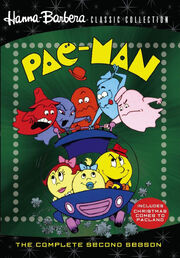
DVD cover to Pac-Man: The Complete Second Season.
Christmas Comes to Pac-Land received a VHS release in North America in 1988, produced by Kids Klassics. The special was the only episode in the series to receive a VHS release in the region.
The Australian company Rainbow Products Ltd. released two PAL VHS tapes in 1983: The adventures of Pac-Man and Pac-Man and family. The first tape features seven episode segments, while the second tape features six. Both releases are noted as being somewhat rare.
Warner Bros. Home Entertainment released the complete first season of the series on DVD on January 31, 2012; they then released the complete second season on September 11, 2012. The second DVD also includes Christmas Comes to Pac-Land. Both items are sold at WBShop.com and are not available in most retail stores.
Trivia[]
- The series would inspire the creation of Namco's 1984 arcade game, Pac-Land. Many elements introduced in the TV series would become staples within later releases of the Pac-Man series, including Pac-Man 2: The New Adventures, Chomp-Chomp, Sue gaining a unique design and more.
- Pac-Man is one of the earliest instances where the personalities of ghosts Blinky and Clyde are swapped, commencing the Clyde and Blinky error.
- The show's initial success inspired ABC's rival CBS to create Saturday Supercade, a block of video game themed cartoons based on properties such as Donkey Kong, Q*bert, and Frogger.
- The Pac-Man TV show seemed to do the most successful when it was broadcasted in Italy, receiving toys and other merchandise based on the show that weren't available in other parts of the world.
- The Tengen Nintendo Entertainment System release of Pac-Man features the designs of this series on the box artwork. The later 1993 release by Namco features different artwork; coincidentally, this non-cartoon-themed cover was designed by former Hanna-Barbera artist Greg Martin, who also worked on the animated series.
Gallery[]
Artwork[]
Screen Stills[]
References[]
- ↑ 1.0 1.1 Jones, Shirley, and Marty Ingels. Shirley & Marty: An Unlikely Love Story. Morrow, 1990.
- ↑ https://cartoonresearch.com/index.php/animation-anecdotes-258/
- ↑ 3.0 3.1 3.2 “Look out Saturday Morning TV! Here Comes... PAC-MAN-IMATION!” Electronic Fun with Computer & Games, Nov. 1982, pp. 44–46.
- ↑ https://cartoonresearch.com/index.php/animation-anecdotes-103/
- ↑ https://youtu.be/xMXiw4b9pPE



